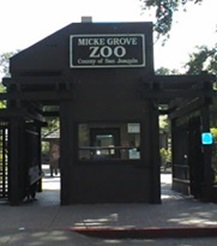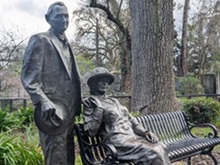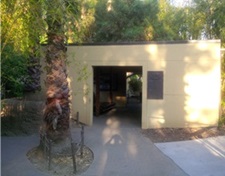Micke Grove Zoo and the park in which it is
located, Micke Grove Park, were gifted to the people of San Joaquin
County by local philanthropists William and Julia Harrison Micke.
Their legacy lives on in the beautiful oak forested park that opened
in 1938 as well as in the many improvements that are seen in the
park today. Besides the zoo, Micke Grove Park also features a
Japanese Garden, San Joaquin County Historical Museum, the Micke
Grove Amusement Park and several picnic shelters located in scenic
settings.
Micke Grove Zoo is a five-acre zoo with a collection of animals that
includes mammals, birds, reptiles, amphibians and invertebrates. The
zoo has evolved since it first opened its gates to the public in
1957. Today, the emphasis is on the zoo’s uniqueness and quality
over size and quantity with a focus on unique species and the
welfare of the animal ambassadors that live here. One of the goals
of the zoo is to help conserve threatened the unique wildlife that
live in Madagascar, a small island off the eastern coast of Africa.
Some of the Madagascan species that can be seen at Micke Grove Zoo
are the black and white ruffed lemurs (Varecia variegata),
red ruffed lemurs (Varecia rubra), ring-tailed lemurs (Lemur
catta), the Standing's day gecko (Phelsuma standingi),
the giant Madagascar day gecko (Phelsuma grandis), golden
mantella frogs (Mantella aurantiaca), the Madagascar black
parrot (Coracopsis nigra), a Dumeril's boa (Acrantophis
dumerili), and radiated tortoises (Astrochelys radiata).
Micke Grove Zoo is one of many zoos that participates in SSP
programs conducted by the Association of Zoos and Aquariums which
help facilitate the breeding of threatened wildlife on the verge of
extinction in the wild. The zoo has successfully bred several
threatened species, including golden-lion tamarins (Leontopithecus
rosalia), southern pudus (Pudu puda), northern bald
ibises (Geronticus eremita), marbled teal (Marmaronetta
angustirostris), and snow leopards (Panthera uncia).
Micke Grove Zoo is passionate about the contribution it makes to
conserve wildlife and uses every opportunity to educate students and
zoo visitors on natural history, behavioral biology, threats, and
conservation impacts for the species that reside in the zoo.
Micke Grove Zoo
SJGOV.org - How can we serve you today?
About Us

The zoo nestles inside the Micke Grove Park

These incredible status of William and Julia Micke were sculpted by Rowland Cheney and were moved to Micke Grove Zoo
Threatened native western pond turtles live in Duck Pond in the zoo
Threatened northern bald ibises live in the large Gardner Mediterranean Aviary

The Viewing Shelter is located in the center of the zoo and it houses Madagascan animals